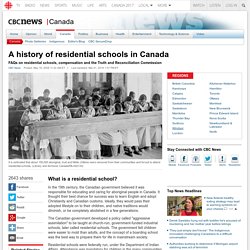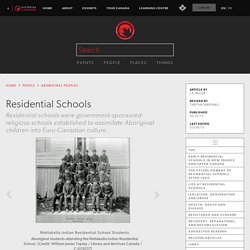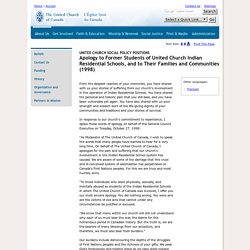

TEACH Magazine Nov/Dec 2015 by TEACH Magazine. Treaty Walks: Treaty Essential Learnings. Native Studies Research/Inquiry Project.

This little book can help you research almost all of the topics. See the table of contents below. Treaties: The entire book gives you information about the Treaties in Saskatchewan. The Royal Proclamation of 1763 on page 11 and 19. The Indian Act, 1876 on page 22; Amendments to the Indian Act on page 23; The Status Issue on page 56; and more contemporary thoughts on the Indian Act on page 57. Colonialism Federal First Nation Legislation, 1867 on page 22; The Indian Act on page 22; "The Davin Report, 1879 on page 22; The Department of Indian Affairs (DIA) on page 22 and more... Where Are The Children. A history of residential schools in Canada. What is a residential school?

In the 19th century, the Canadian government believed it was responsible for educating and caring for aboriginal people in Canada. It thought their best chance for success was to learn English and adopt Christianity and Canadian customs. Ideally, they would pass their adopted lifestyle on to their children, and native traditions would diminish, or be completely abolished in a few generations. The Canadian government developed a policy called "aggressive assimilation" to be taught at church-run, government-funded industrial schools, later called residential schools. The government felt children were easier to mold than adults, and the concept of a boarding school was the best way to prepare them for life in mainstream society. Residential schools were federally run, under the Department of Indian Affairs. How many residential schools and students were there? Initially, about 1,100 students attended 69 schools across the country.
What went wrong? Residential Schools. Residential schools were government-sponsored religious schools established to assimilate Aboriginal children into Euro-Canadian culture.

Metlakatla Indian Residential School Students Aboriginal students attending the Metlakatla Indian Residential School. (Credit: William James Topley / Library and Archives Canada / C-015037) R.C. Indian Residential School R.C. Government School Father Joseph Hugonnard, principal, with staff and aboriginal students of the Industrial School, May 1885, Fort Qu'Appelle, Sask (O.B. Residential schools were government-sponsored religious schools established to assimilate Aboriginal children into Euro-Canadian culture. Early Residential Schools in New France and Upper Canada Although residential schools are usually considered part of the assimilative policies that the Canadian government directed at Aboriginal peoples from the 1880s onward, their roots lie deeper.
What is Project of Heart? Project of Heart” is an inquiry based, hands-on, collaborative, inter-generational, artistic journey of seeking truth about the history of Aboriginal people in Canada.

Its purpose is to: Apology to Former Students of United Church Indian Residential Schools, and to Their Families and Communities (1998) From the deepest reaches of your memories, you have shared with us your stories of suffering from our church's involvement in the operation of Indian Residential Schools.

You have shared the personal and historic pain that you still bear, and you have been vulnerable yet again. You have also shared with us your strength and wisdom born of the life-giving dignity of your communities and traditions and your stories of survival. In response to our church's commitment to repentance, I spoke these words of apology on behalf of the General Council Executive on Tuesday, October 27, 1998: "As Moderator of The United Church of Canada, I wish to speak the words that many people have wanted to hear for a very long time. Statement of apology to former students of Indian Residential Schools. TRC. Reconciliation What does Reconciliation look like?

Does it matter to you? Learn More → TRC Findings View TRC documents presented at the Ottawa Closing Event. Learn More → National Centre for Truth and Reconciliation All of the statements, documents and research gathered by the TRC throughout its mandate will be accessible in a new National Centre for Truth and Reconciliation. Learn More → Stay Connected Take advantage of social media to stay connected with the TRC. Learn More → "Reconciliation is about forging and maintaining respectful relationships.
ORANGE SHIRT DAY - EVERY CHILD MATTERS - Home. File Hills Feast POSTERAug 21'15 alt.